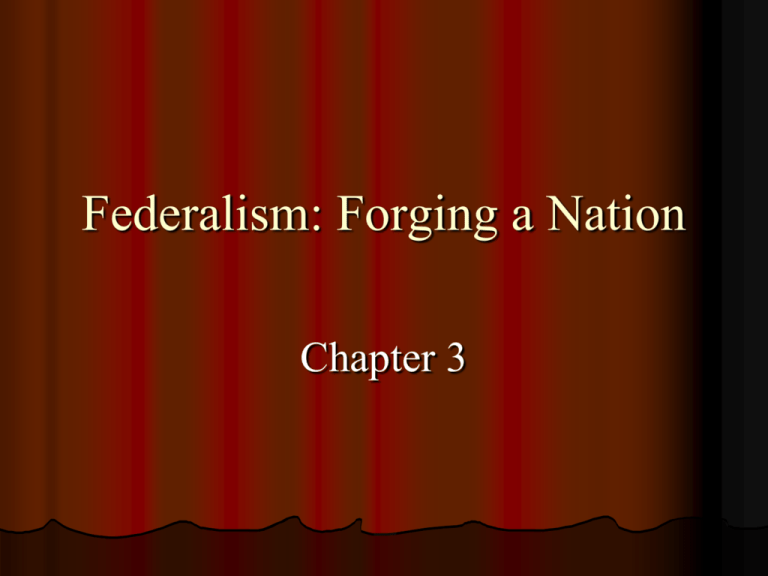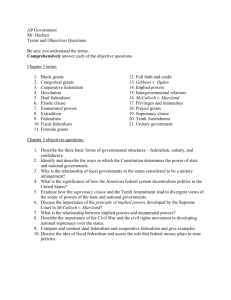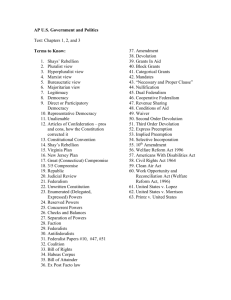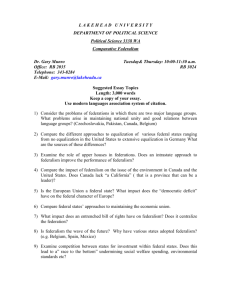
Federalism: Forging a Nation
Chapter 3
Federalism: National and
State Sovereignty
The Argument for Federalism
Authority divided into two levels: national and regional – each directly
governs the people and derives its authority from them
Protects liberty – checks and balances
Moderates the power of the national government – large republic is less
likely to have all powerful factions
Strengthens the union – overcome the problems of the Articles of
Confederation
© 2009 McGraw-Hill Higher Education. All rights reserved.
2
Federalism: National and
State Sovereignty
The Powers of the Nation
Enumerated
(expressed) powers
powers secure defense & stable commerce
Article VI - Supremacy clause
17
Implied
powers
“Necessary
and proper clause
Elastic clause - the authority to take action that is not
expressly authorized by the Constitution but that
supports actions that are expressly authorized
© 2009 McGraw-Hill Higher Education. All rights reserved.
3
Federalism: National and
State Sovereignty
The Powers of the States
Oversight
of local matters: public education and
safety
The national government would take responsibility
for a strong defense and sound economy while the
states would retain nearly all other functions
Tenth
Amendment: reserved powers
© 2009 McGraw-Hill Higher Education. All rights reserved.
4
Figure 3-1
Federalism as a Governing
System: Examples of National,
State, and Concurrent Powers
© 2009 McGraw-Hill Higher Education. All rights reserved.
5
Federalism in Historical Perspective
Two levels of authority would be sure to conflict
from time to time
Framers provided vagueness in the Constitution so
that flexibility would be sought between the two
levels
An indestructible union (1789-1865)
The nationalist view: McCulloch v. Maryland (1819)
The states’-rights view: the Dred Scott Decision (1857)
© 2009 McGraw-Hill Higher Education. All rights reserved.
6
Federalism in Historical Perspective
Dual federalism and laissez-faire capitalism
(1865-1937)
Dual federalism: separation of national from state power was possible
and desirable
Who would regulate business? Would the federal government be
allowed to intervene to ensure fair treatment of African Americans?
This era was characterized by state supremacy in racial policy and
business supremacy in commerce policy
The Fourteenth Amendment and state discretion
Plessy v. Ferguson
© 2009 McGraw-Hill Higher Education. All rights reserved.
7
DUAL FEDERALISM
Judicial protection of business: Supreme Court limited national power
Laissez – faire capitalism
Corporations were persons
Courts narrowly interpreted the national government’s commerce
power
National authority prevails starting in 1937
Court packing by Roosevelt
The court who had originally ruled much of the New Deal
unconstitutional now had a majority of Democrats
The court granted Congress the authority to broadly apply its
commerce powers
Brown v. BOE – national citizenship
© 2009 McGraw-Hill Higher Education. All rights reserved.
8
Federalism Today
1930s and on have shown a continued expansion of national
authority
Great Society programs
The ability to tax without being hurt population wise
Interdependency and intergovernmental relations
Cooperative federalism: shared policy responsibilities
National, state, and local levels work together
Joint funding, administration, and determination of
programs
© 2009 McGraw-Hill Higher Education. All rights reserved.
9
Federalism Today
Government revenues and
intergovernmental relations
Fiscal federalism: federal funds used for state programs
Grants–in–aid (cash payments)
If states accept the money they must spend it in the way
specified by congress
Categorical
and block grants
Federal
funds restricted to certain state programs
Federal funds for state programs addressed to a general
concern
© 2009 McGraw-Hill Higher Education. All rights reserved.
10
Federalism Today
Devolution
Shift of power from national government to states
New federalism
The Republican Revolution – reduce unfunded mandates, increase
block grants
Welfare Reform Act of 1996
Devolution, judicial style
United States v. Lopez
11th amendment
© 2009 McGraw-Hill Higher Education. All rights reserved.
11
The Public’s Influence
Setting the boundaries of federal-state power
Roosevelt’s “New Deal” jobs during the Great
Depression
Lyndon Johnson’s “Great Society” increased social
services in 1960s
Republican Revolution rolled back federal authority in
1990s
Framers felt that Americans would shift their loyalties
between the nation and the states according to their needs at
that time
© 2009 McGraw-Hill Higher Education. All rights reserved.
12









